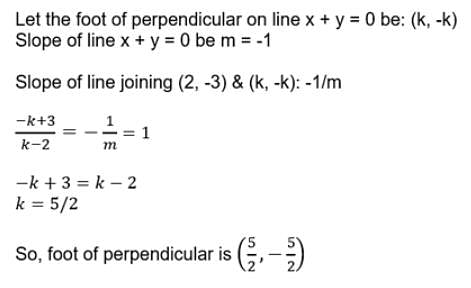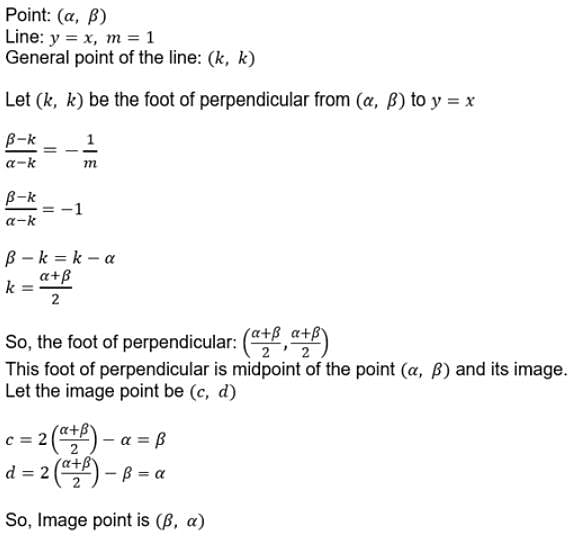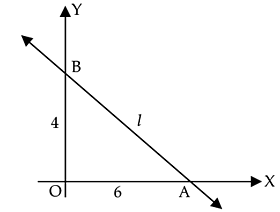All Exams >
MAT >
Geometry for MAT >
All Questions
All questions of Straight Lines & Properties for MAT Exam
| 1 Crore+ students have signed up on EduRev. Have you? Download the App |
The line through the points (a , b) and (- a , - b) passes through the point- a)(1 , 1)
- b)(a2,ab)
- c)(3a , - 2b)
- d)none of these
Correct answer is option 'B'. Can you explain this answer?
The line through the points (a , b) and (- a , - b) passes through the point
a)
(1 , 1)
b)
(a2,ab)
c)
(3a , - 2b)
d)
none of these
|
|
Naina Sharma answered |
Slope of line passing through (a,b) and (−a,−b) is given by (b+b)/(a+a) = b/a
So equation of line passing is given by (using slope point form)
y−b = b/a(x−a)
⇒ ay − ab = bx − ab
⇒ ay = bx
Clearly the point (a2,ab) lie on the above line
So equation of line passing is given by (using slope point form)
y−b = b/a(x−a)
⇒ ay − ab = bx − ab
⇒ ay = bx
Clearly the point (a2,ab) lie on the above line
The acute angle between the lines ax + by + c = 0 and (a + b)x = (a – b)y , a ≠ b , is- a)450
- b)300
- c)600
- d)150
Correct answer is option 'A'. Can you explain this answer?
The acute angle between the lines ax + by + c = 0 and (a + b)x = (a – b)y , a ≠ b , is
a)
450
b)
300
c)
600
d)
150
|
|
Aryan Khanna answered |
ax + by + c = 0 and (a + b)x = (a – b)y
m1 = -a/b, m2 = (a+b)/(a-b)
tanx = [(m1-m2)/(1+m1×m2)]
=> {(-a/b)- (a+b)/(a-b)}/{1+(-a/b)[(a+b)/(a-b)]}
=> {-a2+ab-ab-b2}/{b(a-b)} * {ba-b2-a2-ab}/{b(a-b)}
=> (-a2-b2)/{1/(-a2-b2)
tanx = 1
x = tan-1(1)
Angle = 45o
m1 = -a/b, m2 = (a+b)/(a-b)
tanx = [(m1-m2)/(1+m1×m2)]
=> {(-a/b)- (a+b)/(a-b)}/{1+(-a/b)[(a+b)/(a-b)]}
=> {-a2+ab-ab-b2}/{b(a-b)} * {ba-b2-a2-ab}/{b(a-b)}
=> (-a2-b2)/{1/(-a2-b2)
tanx = 1
x = tan-1(1)
Angle = 45o
The vertices of a triangle are (0 , 3) , (- 3 , 0) and (3 , 0). The orthocenter of the triangle is- a)(0 , 3)
- b)(- 3 , 0)
- c)(3 , 0)
- d)none of these.
Correct answer is option 'A'. Can you explain this answer?
The vertices of a triangle are (0 , 3) , (- 3 , 0) and (3 , 0). The orthocenter of the triangle is
a)
(0 , 3)
b)
(- 3 , 0)
c)
(3 , 0)
d)
none of these.

|
Dipika Choudhury answered |
Method to Solve :Triangle ABC, vertices are A(3,4)... more, B(0,0), C(4,0)O is the Orthocentre of the triangleBy considering the coordinates of B, C, A ,we can conclude that:Equation of BC is y=0………..(1)Equati
Projection (the foot of perpendicular) from (x , y) on the x – axis is- a)(0 , y)
- b)(0 , - y)
- c)(- x , 0)
- d)(x , 0)
Correct answer is option 'D'. Can you explain this answer?
Projection (the foot of perpendicular) from (x , y) on the x – axis is
a)
(0 , y)
b)
(0 , - y)
c)
(- x , 0)
d)
(x , 0)
|
|
Sarita Yadav answered |
Slope of a line is not defined if the line is parallel to x axis as all points on the line have same x coordinate.
Two points (a , 0) and (0 , b) are joined by a straight line. Another point on this line is- a)(- 3a , 2b)
- b)(a , - 2b)
- c)(3a , - 2b)
- d)none of these
Correct answer is option 'C'. Can you explain this answer?
Two points (a , 0) and (0 , b) are joined by a straight line. Another point on this line is
a)
(- 3a , 2b)
b)
(a , - 2b)
c)
(3a , - 2b)
d)
none of these
|
|
Rajat Patel answered |
ing (a,0) to (0,b).
Substituting the x-coordinate of (3a,-2b) into the equation we can find if that point lies on the same line.
For x=3a, the point on the line has
y=(-b/a)(3a)+b=-3b+b=-2b so point (3a,-2b) lies on the same line as the other two points
Slope of a line is not defined if the line is- a)parallel to the line x – y
- b)parallel to the line x+y
- c)parallel to Y axis
- d)parallel to X axis
Correct answer is option 'C'. Can you explain this answer?
Slope of a line is not defined if the line is
a)
parallel to the line x – y
b)
parallel to the line x+y
c)
parallel to Y axis
d)
parallel to X axis
|
|
Sanghamitra Maithani answered |
As the formula for slope is given by tan theta . where theta is angle from +ve X axis and if the line is parallel to y axis then the angle from X axis is 90 and tan 90 is not defined.
The line x + y – 6 = 0 is the right bisector of the segment [PQ]. If P is the point (4, 3) , then the point Q is- a)(4 , 4)
- b)(3, 4)
- c)(3 , 3)
- d)(3, 2)
Correct answer is option 'D'. Can you explain this answer?
The line x + y – 6 = 0 is the right bisector of the segment [PQ]. If P is the point (4, 3) , then the point Q is
a)
(4 , 4)
b)
(3, 4)
c)
(3 , 3)
d)
(3, 2)
|
|
Arjun Singhania answered |
X-4y-6 = 0
Express in the form of y=mx+c, where m is the slope
x-4y-6=0
-4y = -x+6
y=1/4 x - 3,2
The triangle formed by the lines x + y = 1, 2x + 3y – 6 = 0 and 4x – y + 4 = 0 lies in- a)1th quadrant
- b)4th quadrant
- c)2nd quadrant
- d)3rd quadrant
Correct answer is option 'C'. Can you explain this answer?
The triangle formed by the lines x + y = 1, 2x + 3y – 6 = 0 and 4x – y + 4 = 0 lies in
a)
1th quadrant
b)
4th quadrant
c)
2nd quadrant
d)
3rd quadrant
|
|
Chirag Verma answered |
We have,
x+y=1......(1)
2x+3y=6......(2)
4x−y=−4......(3)
From equation (1) and (2) to and we get,
(x+y=1)×2
2x+3y=6
2x+2y=2
2x+3y=6
On subtracting and we get,
y=4 put in (1) and we get,
2x+2y=2
2x+2(4)=2
2x+8=2
2x=−6
x=−3
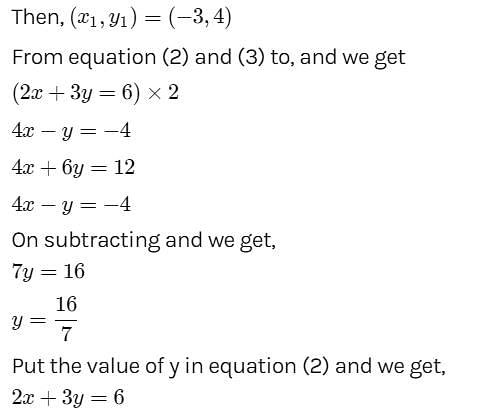
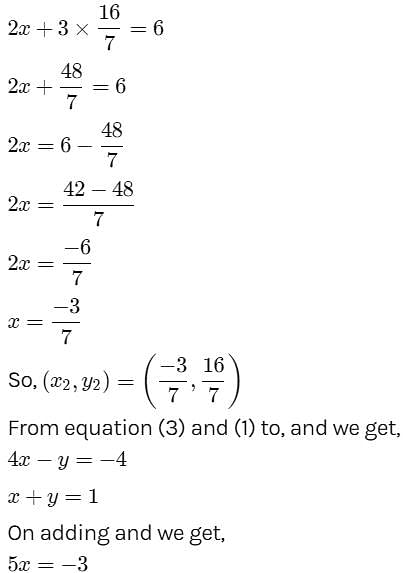


Hence, this is the answer.




Hence, this is the answer.
The line passing through (1, 1) and parallel to the line 2x – 3y + 5 = 0 is- a)2x – 3y + 1= 0
- b)3x – 2y = 1
- c)2x + 3y = 5
- d)3x + 2y = 5
Correct answer is option 'A'. Can you explain this answer?
The line passing through (1, 1) and parallel to the line 2x – 3y + 5 = 0 is
a)
2x – 3y + 1= 0
b)
3x – 2y = 1
c)
2x + 3y = 5
d)
3x + 2y = 5
|
|
Shadow answered |
Eqn ll'el 2x-3y+5 =0 ,2x-3y+K=0 ..(l) It is passing through (1,1)-->K=1,Rqd eqn 2x-3y +1=0
The distance of the point (x , y) from Y axis is- a)x
- b)|x|
- c)|y|
- d)y
Correct answer is option 'B'. Can you explain this answer?
The distance of the point (x , y) from Y axis is
a)
x
b)
|x|
c)
|y|
d)
y
|
|
Geetika Shah answered |
Distance is a metric, a bifunction d, which is always non-negative, along with being symmetric, satisfies the triangle inequality, and the identity of indiscernibles (i.e., d(x,y)=0⟺x=y)
d(x,y)=0⟺x=y). The “nearest” distance from a point (x1,y1) to the y-axis in 2-space is along the line y=y1. (orthogonal to the y-axis). This line interests the y-axis exactly at the point (0,y1). Using the Euclidean distance metric on R2, one obtains:
d((x,y),(0,y))= √(x−0)2+(y−y)2
= |x|
d(x,y)=0⟺x=y). The “nearest” distance from a point (x1,y1) to the y-axis in 2-space is along the line y=y1. (orthogonal to the y-axis). This line interests the y-axis exactly at the point (0,y1). Using the Euclidean distance metric on R2, one obtains:
d((x,y),(0,y))= √(x−0)2+(y−y)2
= |x|
The lines y = mx , y + 2x = 0 , y = 2x + λ and y = - mx + λ form a rhombus if m =- a)2
- b)- 1
- c)1
- d)none of these
Correct answer is option 'A'. Can you explain this answer?
The lines y = mx , y + 2x = 0 , y = 2x + λ and y = - mx + λ form a rhombus if m =
a)
2
b)
- 1
c)
1
d)
none of these

|
Rithika Mishra answered |
Y=mx, y+2x=0 intersects at (0,0) and y=2x+k and y+mx=k intersect at (o,k).If you draw them then you can easily identify that m should be equal to 2 for lines to make Rhombus.
The distance between the lines 4x + 3y = 11 and 8x + 6y = 15 is ?- a)0.7
- b)7/2
- c)4
- d)none of these
Correct answer is option 'A'. Can you explain this answer?
The distance between the lines 4x + 3y = 11 and 8x + 6y = 15 is ?
a)
0.7
b)
7/2
c)
4
d)
none of these
|
|
Vicky Kumar answered |
First of all , we divide by 2 in eq. (ii)
then use this formula . D2-D1/(a^2+b^2)^1/2...
The area of the triangle whose sides are along the lines x = 0 , y = 0 and 4x + 5y = 20 is- a)1/10
- b)20
- c)10
- d)none of these
Correct answer is option 'C'. Can you explain this answer?
The area of the triangle whose sides are along the lines x = 0 , y = 0 and 4x + 5y = 20 is
a)
1/10
b)
20
c)
10
d)
none of these
|
|
Alok Mehta answered |
The correct answer is c) 10.
To find the area of a triangle, you can use the formula:
Area = (1/2) * base * height
In this case, the sides of the triangle are along the lines x = 0, y = 0, and 4x + 5y = 20. The line x = 0 represents the y-axis, and the line y = 0 represents the x-axis. These two lines intersect at the point (0,0), which is one of the vertices of the triangle.
To find the other vertex of the triangle, you can substitute 0 for x in the equation 4x + 5y = 20 and solve for y:
4x + 5y = 20
4(0) + 5y = 20
5y = 20
y = 4
This means that the other vertex of the triangle is at the point (0,4).
To find the length of the base of the triangle, you can use the distance formula to calculate the distance between the points (0,0) and (0,4):
Base = sqrt((0 - 0)^2 + (4 - 0)^2)
Base = sqrt((0 - 0)^2 + 4^2)
Base = sqrt(4^2)
Base = 4
To find the height of the triangle, you can use the slope-intercept form of a linear equation to rewrite the equation 4x + 5y = 20 as y = -4/5x + 4:
y = -4/5x + 4
The slope of the line is -4/5, and the y-intercept is 4. This means that the line passes through the point (0,4) and has a slope of -4/5. The line perpendicular to the base of the triangle will have a slope of -5/4, and it will pass through the point (0,4).
To find the y-coordinate of the third vertex of the triangle, you can substitute 0 for x in the equation y = -5/4x + 4:
y = -5/4x + 4
y = -5/4(0) + 4
y = 4
This means that the third vertex of the triangle is also at the point (0,4).
Since all three vertices of the triangle are at the same point, the triangle is a degenerate triangle with no area. Therefore, the area of the triangle is 0.
The answer choices provided do not include 0, so the correct answer is d) none of these.
The number of points on X axis which are at a distance of c units (c < 3) from (2 , 3) is- a)3
- b)2
- c)0
- d)1
Correct answer is option 'C'. Can you explain this answer?
The number of points on X axis which are at a distance of c units (c < 3) from (2 , 3) is
a)
3
b)
2
c)
0
d)
1

|
Puja Das answered |
Is a positive integer) from both the origin and the point (a,b) is equal to the absolute difference between a and b.
To see why this is true, consider a point on the X axis that is c units away from both the origin and (a,b). Let this point have coordinates (x,0). Then we have:
- Distance from (x,0) to the origin = x
- Distance from (x,0) to (a,b) = sqrt((x-a)^2 + b^2)
Since we want these distances to be equal to c, we can set up the following equations:
x^2 = c^2
(x-a)^2 + b^2 = c^2
Solving for x in the first equation, we get x = c or x = -c. Substituting these values into the second equation and simplifying, we get:
c = abs(a-b) or c = abs(a+b)
(Note that we took the square root of both sides of the second equation, which introduces a plus/minus sign. However, we can ignore the negative solution since we are only interested in points on the positive X axis.)
Therefore, if c = abs(a-b), then there is exactly one point on the X axis that satisfies both distance conditions (namely, the point (c,0)). If c = abs(a+b), then there are exactly two points on the X axis that satisfy both distance conditions (namely, the points (-c,0) and (c,0)).
In either case, the number of points is equal to the absolute difference between a and b. For example, if a = 5 and b = 2, then c = abs(5-2) = 3, and there is exactly one point on the X axis that is 3 units away from both (0,0) and (5,2): namely, the point (3,0). Similarly, if a = 5 and b = 8, then c = abs(5+8) = 13, and there are exactly two points on the X axis that are 13 units away from both (0,0) and (5,8): namely, the points (-13,0) and (13,0).
To see why this is true, consider a point on the X axis that is c units away from both the origin and (a,b). Let this point have coordinates (x,0). Then we have:
- Distance from (x,0) to the origin = x
- Distance from (x,0) to (a,b) = sqrt((x-a)^2 + b^2)
Since we want these distances to be equal to c, we can set up the following equations:
x^2 = c^2
(x-a)^2 + b^2 = c^2
Solving for x in the first equation, we get x = c or x = -c. Substituting these values into the second equation and simplifying, we get:
c = abs(a-b) or c = abs(a+b)
(Note that we took the square root of both sides of the second equation, which introduces a plus/minus sign. However, we can ignore the negative solution since we are only interested in points on the positive X axis.)
Therefore, if c = abs(a-b), then there is exactly one point on the X axis that satisfies both distance conditions (namely, the point (c,0)). If c = abs(a+b), then there are exactly two points on the X axis that satisfy both distance conditions (namely, the points (-c,0) and (c,0)).
In either case, the number of points is equal to the absolute difference between a and b. For example, if a = 5 and b = 2, then c = abs(5-2) = 3, and there is exactly one point on the X axis that is 3 units away from both (0,0) and (5,2): namely, the point (3,0). Similarly, if a = 5 and b = 8, then c = abs(5+8) = 13, and there are exactly two points on the X axis that are 13 units away from both (0,0) and (5,8): namely, the points (-13,0) and (13,0).
The point which divides the joint of (1, 2) and (3,4) externally in the ratio 1 : 1 .- a)lies in the 1st quadrant
- b)lies in 3rd quadrant
- c)lies in the 2nd quadrant
- d)cannot be found
Correct answer is option 'D'. Can you explain this answer?
The point which divides the joint of (1, 2) and (3,4) externally in the ratio 1 : 1 .
a)
lies in the 1st quadrant
b)
lies in 3rd quadrant
c)
lies in the 2nd quadrant
d)
cannot be found
|
|
Nandini Patel answered |
as we know that for the co ordinates of a point whic divides externally in ratio m:n
(x,y)=(mx2-nx1)/m-n, (my2-my1)/m-n
let us take x1=1,y1=2
x2=3 , y2=4
m=1, n=1
by the above formula
(1*3-1*1)/1-1 (1*4-1*2)/1-1
we will get x,y as infinity so we can say there is no point which divides line in ratio 1:1 externally for any line joining two points
The acute angle between the lines x – y = 0 and y = 0 is- a)450
- b)750
- c)300
- d)600
Correct answer is option 'A'. Can you explain this answer?
The acute angle between the lines x – y = 0 and y = 0 is
a)
450
b)
750
c)
300
d)
600
|
|
Mohit Mittal answered |
It's clearly seen one line is perpendicular to x axis and another is made 45 degree with x axis
so angle between them is 45 degree
Given the 4 lines with equations x + 2y – 3 = 0, 2x + 3y – 4 = 0, 3x + 4y – 5 = 0, 4x + 5y – 6 = 0 , then these lines are- a)sides of a parallelogram
- b)the sides of a quadrilateral
- c)concurrent
- d)none of these
Correct answer is option 'C'. Can you explain this answer?
Given the 4 lines with equations x + 2y – 3 = 0, 2x + 3y – 4 = 0, 3x + 4y – 5 = 0, 4x + 5y – 6 = 0 , then these lines are
a)
sides of a parallelogram
b)
the sides of a quadrilateral
c)
concurrent
d)
none of these

|
Athul Patel answered |
Here, we are given 4 linesx+2y−3=03x+4y−7=02x+3y−4... more=04x+5y−6=0If, we subtract twice of third equation from fourth equation, we gety=2 and putt
The straight lines x + y = 0 , 3x + y – 4 = 0 , x + 3y – 4 = 0 form a triangle which is- a)equilateral
- b)right angled
- c)isosceles
- d)none of these
Correct answer is option 'C'. Can you explain this answer?
The straight lines x + y = 0 , 3x + y – 4 = 0 , x + 3y – 4 = 0 form a triangle which is
a)
equilateral
b)
right angled
c)
isosceles
d)
none of these
|
|
Priya Patel answered |
Since none of the lines are perpendicular therefore it is not a right angled triangle.
now find the intersection points of x+y=0, 3x+y-4=0, x+3y-4=0, we get
(2,-2),(-2,2) & (1,1)
let A(2,-2) B(-2,2), C(1,1)
By distance formula we get AC=AB but not equal to AB therefore it is a isoscels triangle.
so option C is correct
Thee perpendicular distance of the origin from the line 3x +4y + 1 = 0 is- a)1
- b)1/5
- c)1/2
- d)none of these
Correct answer is option 'B'. Can you explain this answer?
Thee perpendicular distance of the origin from the line 3x +4y + 1 = 0 is
a)
1
b)
1/5
c)
1/2
d)
none of these
|
|
Ankit Singh answered |
The perpendicular distance (d) of a line Ax + By+ C = 0 from a point (x1 ,y1) is given by d = | Ax1 + by1 + c|/ root (A^2 + B^2) ..... so put (0,0) .
The locus of the equation xy = 0 is- a)a pair of perpendicular lines
- b)a straight line
- c)a hyperbola
- d)none of these
Correct answer is option 'A'. Can you explain this answer?
The locus of the equation xy = 0 is
a)
a pair of perpendicular lines
b)
a straight line
c)
a hyperbola
d)
none of these

|
Lekshmi Bose answered |
Xy=0
either x=0,y=some constant
or y=0,x=some constant

either x=0,y=some constant
or y=0,x=some constant
so it will be a pair of perpendicular lines
Explanation :

The distance of the point (x, y) from the origin is- a)x + y
- b)x
- c)

- d)none of these
Correct answer is option 'C'. Can you explain this answer?
The distance of the point (x, y) from the origin is
a)
x + y
b)
x
c)
d)
none of these
|
|
Ssssssss Ddd answered |
Origin is 0,0....then using distance formula
underroot of (x-0)^2 +(y-0)^2 = under root of x^2 + y^2
The lines x + 2y – 3 = 0, 2x + y – 3 = 0 and the line l are concurrent. If the line I passes through the origin, then its equation is- a)x – y = 0
- b)x + y + 0
- c)x + 2y = 0
- d)none of these
Correct answer is option 'A'. Can you explain this answer?
The lines x + 2y – 3 = 0, 2x + y – 3 = 0 and the line l are concurrent. If the line I passes through the origin, then its equation is
a)
x – y = 0
b)
x + y + 0
c)
x + 2y = 0
d)
none of these
|
|
Arjun Singhania answered |
Let concurrent point be (h,k)Then both line will satisfies this point h+2k-3=0 and2h+k-3=0 By solving these two equations we geth=1and k=1 thus , we have two points (0,0) and (1,1) Therefore by two. Point form of lineThe equation of given line would be X-Y-1=0
By using family of lines the equation ofL is (x+2y-3)+∆(2x+y-3)=0 ,the line passes through origin (0,0).We get ∆=-1-x-y=0x=y
A parking lot in an IT company is triangular shaped with two of its vertices at B(–2, 0) and C(1, 12). The third vertex A is at the midpoint of the line joining the points (1, 1) and (3, 11).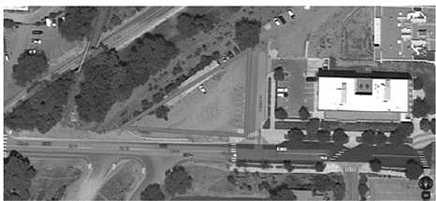 Q. Find the coordinates of A.
Q. Find the coordinates of A.- a)(–1, –5)
- b)(2, 6)
- c)(1, –1)
- d)(–2, –6)
Correct answer is option 'B'. Can you explain this answer?
A parking lot in an IT company is triangular shaped with two of its vertices at B(–2, 0) and C(1, 12). The third vertex A is at the midpoint of the line joining the points (1, 1) and (3, 11).

Q. Find the coordinates of A.
a)
(–1, –5)
b)
(2, 6)
c)
(1, –1)
d)
(–2, –6)

|
Pioneer Academy answered |
A is the midpoint of line segment joining (1, 1) and (3, 11). By midpoint formula,

= (2, 6)
The distance between the parallel lines 3x + 4y + 13 = 0 and 3x + 4y – 13 = 0 is- a)26
- b)26/3
- c)26/4
- d)26/5
Correct answer is option 'D'. Can you explain this answer?
The distance between the parallel lines 3x + 4y + 13 = 0 and 3x + 4y – 13 = 0 is
a)
26
b)
26/3
c)
26/4
d)
26/5
|
|
Akash Joshi answered |
Given parallel lines3x +4y+13=0
perp length from origin P1= 13/√(3)2 +(4)2
=13/5
and another line 3x+4y-13=0 P2= -13/√(3)2+(4)2
=-13/5
Now distance b/w parallel lines
D=P1-P2
=13/5+13/5
=26/5 units
perp length from origin P1= 13/√(3)2 +(4)2
=13/5
and another line 3x+4y-13=0 P2= -13/√(3)2+(4)2
=-13/5
Now distance b/w parallel lines
D=P1-P2
=13/5+13/5
=26/5 units
A parking lot in an IT company is triangular shaped with two of its vertices at B(–2, 0) and C(1, 12). The third vertex A is at the midpoint of the line joining the points (1, 1) and (3, 11).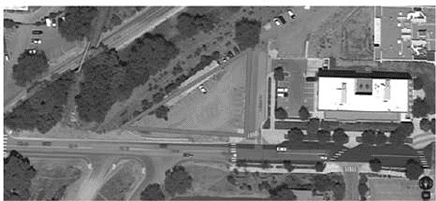 Q. Find the equation of line that passes through the points B(–2, 0) and C(1, 12).
Q. Find the equation of line that passes through the points B(–2, 0) and C(1, 12).- a)y + 4x = 8
- b)4x – y – 8 = 0
- c)4x – y + 8 = 0
- d)4y – 4x = 8
Correct answer is option 'C'. Can you explain this answer?
A parking lot in an IT company is triangular shaped with two of its vertices at B(–2, 0) and C(1, 12). The third vertex A is at the midpoint of the line joining the points (1, 1) and (3, 11).

Q. Find the equation of line that passes through the points B(–2, 0) and C(1, 12).
a)
y + 4x = 8
b)
4x – y – 8 = 0
c)
4x – y + 8 = 0
d)
4y – 4x = 8
|
|
Varun Kapoor answered |
Equation of line through B(–2, 0) and C(1, 12) is given by

4x – y + 8 = 0
The locus of the inequation xy ≥ 0 is- a)a pair of straight lines
- b)the set of all points either in the 1st quadrant or in the 3rd quadrant including the points on coordinate axis
- c)a straight line
- d)none of these
Correct answer is option 'B'. Can you explain this answer?
The locus of the inequation xy ≥ 0 is
a)
a pair of straight lines
b)
the set of all points either in the 1st quadrant or in the 3rd quadrant including the points on coordinate axis
c)
a straight line
d)
none of these

|
Bhavya Joshi answered |
Xy=0
either x=0,y=some constant
or y=0,x=some constant

either x=0,y=some constant
or y=0,x=some constant
so it will be a pair of perpendicular lines

The vertex A of a triangle ABC is the point (-2, 3) whereas the line perpendicular to the sides AB and AC are x – y – 4 = 0 and 2x – y – 5 = 0 respectively. The right bisectors of sides meet at P(3/2 , 5/2) . Then the equation of the median of side BC is- a)5x + 2y = 10
- b)5x – 2y = 16
- c) 2x – 5y = 10
- d) none of these
Correct answer is option 'D'. Can you explain this answer?
The vertex A of a triangle ABC is the point (-2, 3) whereas the line perpendicular to the sides AB and AC are x – y – 4 = 0 and 2x – y – 5 = 0 respectively. The right bisectors of sides meet at P(3/2 , 5/2) . Then the equation of the median of side BC is
a)
5x + 2y = 10
b)
5x – 2y = 16
c)
2x – 5y = 10
d)
none of these

|
Harshad Nair answered |
Method to Solve :
The lines x + (k – 1) y + 1 = 0 and 2x+k2y−1 = 0 are at right angles if- a)k = 1
- b)k = - 1
- c)k > 1
- d)none of these
Correct answer is option 'B'. Can you explain this answer?
The lines x + (k – 1) y + 1 = 0 and 2x+k2y−1 = 0 are at right angles if
a)
k = 1
b)
k = - 1
c)
k > 1
d)
none of these
|
|
Devanshi Bose answered |
I'm sorry, but the question seems to be incomplete or unclear. Can you please provide more information or context?
The equation y−y1 = m (x−x1), m ∈ R, represents all lines through the point (x1,y1) except the line- a)parallel to Y axis
- b)parallel to the line x – y = 0
- c)parallel to X axis
- d)none of these
Correct answer is option 'A'. Can you explain this answer?
The equation y−y1 = m (x−x1), m ∈ R, represents all lines through the point (x1,y1) except the line
a)
parallel to Y axis
b)
parallel to the line x – y = 0
c)
parallel to X axis
d)
none of these
|
|
Aarya Rane answered |
I'm sorry, but you didn't provide the full equation. Could you please provide more information?
The equation of the line which passes through the point (1 , - 2) and cuts off equal intercepts from the axis is- a)x + y + 1 = 0
- b)x + y = 1
- c)x – y – 2 = 0
- d)x – y - 1 = 0
Correct answer is option 'A'. Can you explain this answer?
The equation of the line which passes through the point (1 , - 2) and cuts off equal intercepts from the axis is
a)
x + y + 1 = 0
b)
x + y = 1
c)
x – y – 2 = 0
d)
x – y - 1 = 0
|
|
Sravya Dasgupta answered |
Understanding Equal Intercepts
To find the equation of a line that cuts off equal intercepts from the axes, we start with the general form of such a line:
- The equation can be expressed as:
**x + y = c**,
where **c** is the length of the intercepts, meaning the line cuts off intercepts of length **c** on both the x-axis and y-axis.
Finding the Required Equation
1. **Intercepts of the Line**:
The intercepts are at points (c, 0) and (0, c).
2. **Point on the Line**:
We know the line passes through the point (1, -2). Substituting this point into the equation:
**1 + (-2) = c**
This simplifies to:
**c = -1**.
3. **Substituting c in the Equation**:
Since we have found **c = -1**, we can write the equation of the line:
**x + y = -1**.
4. **Rearranging the Equation**:
Rearranging gives us:
**x + y + 1 = 0**.
Conclusion
Thus, the equation of the line that passes through the point (1, -2) and cuts off equal intercepts from the axes is:
**x + y + 1 = 0**.
The correct answer is option 'A'.
To find the equation of a line that cuts off equal intercepts from the axes, we start with the general form of such a line:
- The equation can be expressed as:
**x + y = c**,
where **c** is the length of the intercepts, meaning the line cuts off intercepts of length **c** on both the x-axis and y-axis.
Finding the Required Equation
1. **Intercepts of the Line**:
The intercepts are at points (c, 0) and (0, c).
2. **Point on the Line**:
We know the line passes through the point (1, -2). Substituting this point into the equation:
**1 + (-2) = c**
This simplifies to:
**c = -1**.
3. **Substituting c in the Equation**:
Since we have found **c = -1**, we can write the equation of the line:
**x + y = -1**.
4. **Rearranging the Equation**:
Rearranging gives us:
**x + y + 1 = 0**.
Conclusion
Thus, the equation of the line that passes through the point (1, -2) and cuts off equal intercepts from the axes is:
**x + y + 1 = 0**.
The correct answer is option 'A'.
The line which passes through the point (0 , 1) and perpendicular to the line x – 2y + 11 = 0 is- a)2x + y – 1 = 0
- b)2x – y + 1 = 0
- c)2x – y + 3 = 0
- d)none of these
Correct answer is option 'A'. Can you explain this answer?
The line which passes through the point (0 , 1) and perpendicular to the line x – 2y + 11 = 0 is
a)
2x + y – 1 = 0
b)
2x – y + 1 = 0
c)
2x – y + 3 = 0
d)
none of these
|
|
Ankita Mishra answered |
To find the equation of the line that passes through the point (0, 1) and is perpendicular to the line x = 2, we need to find the slope of the perpendicular line.
The line x = 2 is a vertical line with undefined slope. Any line perpendicular to a vertical line will have a slope of 0.
Therefore, the line passing through (0, 1) and perpendicular to x = 2 will have a slope of 0.
Using the point-slope form of a linear equation, which is y - y1 = m(x - x1), where (x1, y1) is a point on the line and m is the slope, we can write the equation of the line as:
y - 1 = 0(x - 0)
Simplifying this equation, we get:
y - 1 = 0
Therefore, the equation of the line passing through (0, 1) and perpendicular to x = 2 is y = 1.
The line x = 2 is a vertical line with undefined slope. Any line perpendicular to a vertical line will have a slope of 0.
Therefore, the line passing through (0, 1) and perpendicular to x = 2 will have a slope of 0.
Using the point-slope form of a linear equation, which is y - y1 = m(x - x1), where (x1, y1) is a point on the line and m is the slope, we can write the equation of the line as:
y - 1 = 0(x - 0)
Simplifying this equation, we get:
y - 1 = 0
Therefore, the equation of the line passing through (0, 1) and perpendicular to x = 2 is y = 1.
The equation of the line which passes through the point (2 , - 3) and cuts off equal intercepts from the axis is- a)x + y + 1 = 0
- b)x – y = 1
- c)x – y – 2 = 0
- d)x + y = 1
Correct answer is option 'A'. Can you explain this answer?
The equation of the line which passes through the point (2 , - 3) and cuts off equal intercepts from the axis is
a)
x + y + 1 = 0
b)
x – y = 1
c)
x – y – 2 = 0
d)
x + y = 1

|
Ameya Basu answered |
The equation of a line passing through the point (2, -3) can be written in the form y = mx + b, where m is the slope of the line and b is the y-intercept.
Since the line cuts off equal intercepts from the x-axis and y-axis, the distance from the point (2, -3) to the x-axis is equal to the distance from the point (2, -3) to the y-axis.
The distance from a point (x, y) to the x-axis is given by |y|, and the distance from a point (x, y) to the y-axis is given by |x|. Therefore, |x - 2| = |-3| = 3.
Since the line passes through the point (2, -3), we can substitute x = 2 into the equation |x - 2| = 3 and solve for y. We get |2 - 2| = 3, which simplifies to 0 = 3, which is not true. Therefore, there is no line that passes through the point (2, -3) and cuts off equal intercepts from the x-axis and y-axis.
Therefore, the correct answer is: None of the above.
Since the line cuts off equal intercepts from the x-axis and y-axis, the distance from the point (2, -3) to the x-axis is equal to the distance from the point (2, -3) to the y-axis.
The distance from a point (x, y) to the x-axis is given by |y|, and the distance from a point (x, y) to the y-axis is given by |x|. Therefore, |x - 2| = |-3| = 3.
Since the line passes through the point (2, -3), we can substitute x = 2 into the equation |x - 2| = 3 and solve for y. We get |2 - 2| = 3, which simplifies to 0 = 3, which is not true. Therefore, there is no line that passes through the point (2, -3) and cuts off equal intercepts from the x-axis and y-axis.
Therefore, the correct answer is: None of the above.
A line 'l' passes through the points A and B in the coordinate axes as shown in the figure.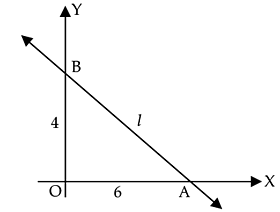 Q. Circumcenter of ΔAOB is at ...............
Q. Circumcenter of ΔAOB is at ...............- a)(6, 0)
- b)(0, 4)
- c)(2, 3)
- d)(3, 2)
Correct answer is option 'D'. Can you explain this answer?
A line 'l' passes through the points A and B in the coordinate axes as shown in the figure.

Q. Circumcenter of ΔAOB is at ...............
a)
(6, 0)
b)
(0, 4)
c)
(2, 3)
d)
(3, 2)
|
|
Raghav Bansal answered |
ΔAOB is a right angled triangle. Circumcenter of a right angled triangle is the midpoint of the hypotenuse.
Circumcenter of ΔAOB = midpoint of AB

A line 'l' passes through the points A and B in the coordinate axes as shown in the figure.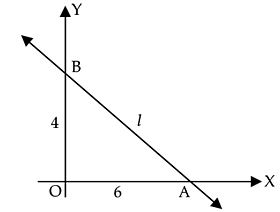 Q. Equation of AB is ................
Q. Equation of AB is ................- a)3x + 2y = 12
- b)2x + 3y = 12
- c)3x – 2y = 12
- d)2x – 3y = 12
Correct answer is option 'B'. Can you explain this answer?
A line 'l' passes through the points A and B in the coordinate axes as shown in the figure.

Q. Equation of AB is ................
a)
3x + 2y = 12
b)
2x + 3y = 12
c)
3x – 2y = 12
d)
2x – 3y = 12
|
|
Preeti Iyer answered |
Equation of AB is x/6 + y/4 = 1
⇒ 2x + 3y = 12
The lines ix + my + n = 0 , mx + ny + l = 0 and nx + ly +m = 0 are concurrent if- a)l + m – n = 0
- b)l + m + n = 0
- c)l – m – n = 0
- d)I – m + n = 0
Correct answer is option 'B'. Can you explain this answer?
The lines ix + my + n = 0 , mx + ny + l = 0 and nx + ly +m = 0 are concurrent if
a)
l + m – n = 0
b)
l + m + n = 0
c)
l – m – n = 0
d)
I – m + n = 0

|
Manisha Choudhary answered |
Suppose we have three straight lines whose equations are:
a₁x + b₁y + c₁ = 0,
a₂x + b₂y + c₂ = 0
a₃x + b₃y + c₃ = 0.
These lines are said to be concurrent if the following condition holds:
Determinant of
a₁ b₁ c₁
a₂ b₂ c₂ = 0
a₃ b₃ c₃
n l m
l(nm - l�) - m(m� - nl) + n(ml - n�) = 0
lmn - l� - m� + lmn + lmn - n� = 0
l� + m� + n� = 3lmn
this condition true if an only if
l + m + n = 0 (In case of l ≠ m ≠ n)
a₁x + b₁y + c₁ = 0,
a₂x + b₂y + c₂ = 0
a₃x + b₃y + c₃ = 0.
These lines are said to be concurrent if the following condition holds:
Determinant of
a₁ b₁ c₁
a₂ b₂ c₂ = 0
a₃ b₃ c₃
Now
l m n
m n l = 0n l m
l(nm - l�) - m(m� - nl) + n(ml - n�) = 0
lmn - l� - m� + lmn + lmn - n� = 0
l� + m� + n� = 3lmn
this condition true if an only if
l + m + n = 0 (In case of l ≠ m ≠ n)
The lines 8x + 4y = 1, 8x + 4y = 5, 4x + 8y = 3, 4x + 8y = 7 form a- a)Square
- b)Rectangle
- c)rhombus
- d)None of these
Correct answer is option 'C'. Can you explain this answer?
The lines 8x + 4y = 1, 8x + 4y = 5, 4x + 8y = 3, 4x + 8y = 7 form a
a)
Square
b)
Rectangle
c)
rhombus
d)
None of these
|
|
Sanjana Mishra answered |
Explanation:
The given set of lines are:
8x 4y = 1 ...(1)
8x 4y = 5 ...(2)
4x 8y = 3 ...(3)
4x 8y = 7 ...(4)
We can rewrite the equations in the form y = mx + c:
Equation (1): y = -2x + 1/4
Equation (2): y = -2x + 5/4
Equation (3): y = 1/2x + 3/8
Equation (4): y = 1/2x + 7/8
Now, we can plot the lines on a graph to see their intersection points and check if they form a rhombus.

As we can see from the graph, the lines intersect at four points forming a quadrilateral. We can also observe that all four sides of the quadrilateral are of equal length. Hence, the quadrilateral formed by the given set of lines is a rhombus.
Therefore, the correct answer is option C.
The given set of lines are:
8x 4y = 1 ...(1)
8x 4y = 5 ...(2)
4x 8y = 3 ...(3)
4x 8y = 7 ...(4)
We can rewrite the equations in the form y = mx + c:
Equation (1): y = -2x + 1/4
Equation (2): y = -2x + 5/4
Equation (3): y = 1/2x + 3/8
Equation (4): y = 1/2x + 7/8
Now, we can plot the lines on a graph to see their intersection points and check if they form a rhombus.

As we can see from the graph, the lines intersect at four points forming a quadrilateral. We can also observe that all four sides of the quadrilateral are of equal length. Hence, the quadrilateral formed by the given set of lines is a rhombus.
Therefore, the correct answer is option C.
Chapter doubts & questions for Straight Lines & Properties - Geometry for MAT 2024 is part of MAT exam preparation. The chapters have been prepared according to the MAT exam syllabus. The Chapter doubts & questions, notes, tests & MCQs are made for MAT 2024 Exam. Find important definitions, questions, notes, meanings, examples, exercises, MCQs and online tests here.
Chapter doubts & questions of Straight Lines & Properties - Geometry for MAT in English & Hindi are available as part of MAT exam.
Download more important topics, notes, lectures and mock test series for MAT Exam by signing up for free.
Geometry for MAT
1 videos|15 docs|4 tests
|
Signup to see your scores go up within 7 days!
Study with 1000+ FREE Docs, Videos & Tests
10M+ students study on EduRev
|
Free Exam Preparation
at your Fingertips!
Access Free Study Material - Test Series, Structured Courses, Free Videos & Study Notes and Prepare for Your Exam With Ease

 Join the 10M+ students on EduRev
Join the 10M+ students on EduRev
|

|
Forgot Password
OR
Signup to see your scores
go up within 7 days!
Access 1000+ FREE Docs, Videos and Tests
Takes less than 10 seconds to signup
